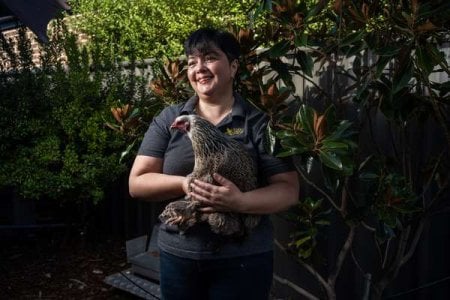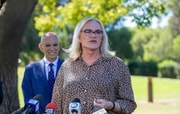The rising cost of living is changing how locals get their food—here’s what we know
By
Maan
- Replies 0
Rising costs and shifting consumer habits have led many Australians to rethink their approach to everyday essentials.
One particular trend has been quietly gaining momentum, offering both a practical solution and an unexpected source of joy.
What started as a niche hobby has now become a widespread movement, with more people embracing a lifestyle that brings them closer to their food sources—sometimes right in their own backyard.
The rising cost of eggs and ongoing shortages in supermarkets have sparked a growing interest in backyard chicken-keeping across Australia, including in urban areas.
Christine Dinas, who has been breeding and selling chickens for over 15 years, believed there was ‘a chicken for everybody’.
‘They all have different personalities,’ she said.
Dinas, who operated Melbourne-based Aussie Chook Supplies and managed several online poultry-keeping communities, found watching chickens ‘scratch around’ to be ‘fascinating and incredibly relaxing’.
Interest in keeping chickens surged during the pandemic when lockdowns prompted people to complete unfinished coops and explore new hobbies.
Joanne Evans, co-owner of NSW-based Evans Chickens, said the demand had not slowed, with her business now selling twice as many chickens as it did five years ago.
‘People are getting a bit jack of supermarket prices and frustrated with going to the supermarket and not being able to get what they want,’ she said.
Victoria’s Mornington Peninsula-based chicken supplier, Talking Hens, reported a 60 per cent increase in inquiries about egg-laying hens compared to the previous year.
Australia’s egg prices had climbed significantly since avian influenza outbreaks led to mass culls in 2024.
A dozen free-range eggs typically sold for around $6, with extra-large varieties reaching up to $9, according to ANZ research.
The Australian Bureau of Statistics reported a 12 per cent rise in egg prices over the past year—far outpacing the 3 per cent increase in overall food costs.
Egg shortages were a global issue, with the US experiencing such steep price hikes that customs officials recorded a 36 per cent increase in people smuggling eggs across borders.
ANZ’s executive director of agribusiness insights, Michael Whitehead, warned that while supply was expected to improve in 2025, it might not return to previous levels.
‘Given the investment required to rebuild and transition farms to meet new welfare standards, and the unpredictable nature of avian disease outbreaks, we may be looking at a new normal for the egg sector—one where price volatility and supply constraints are more common,’ he said.
Australians consumed approximately 250 to 260 eggs per person annually, one of the highest rates worldwide, making the ongoing shortages particularly impactful.
Despite the appeal of backyard chickens as a solution, keeping them came with costs and responsibilities.
Chickens required a fox-proof coop, proper bedding, fencing, and ongoing feed expenses.
Owners might need a specialist vet at some point, and adequate protection against predators was essential.
Hen suppliers recommended a minimum of one square metre per bird in outdoor areas, with additional space preferred.
Netting was often necessary to prevent disease transmission from wild birds, particularly avian influenza, which had been detected at a Victorian egg farm in February.
Chickens, as flock animals, needed to be bought in groups, adding to the initial investment.
Health risks were also a consideration.
A 2022 study found that eggs from backyard hens contained over 40 times the lead levels of commercially produced eggs.
Research conducted across 55 Sydney homes revealed that nearly half of the backyard chickens tested had significant lead concentrations in their blood.
Professor Mark Taylor, the study’s lead author and Victoria’s chief environmental scientist, urged owners to take precautions.
‘Where the soil lead levels are too high…it would be advantageous to clean that top side away and put some new soil in,’ he said.
He reassured that the data did not indicate a serious health risk for humans unless they were consuming excessive amounts of eggs.
Taylor encouraged Victorians to use the state’s free GardenSafe soil testing program to assess potential contamination.
Proper coop conditions were crucial to prevent bacterial infections, parasites, and other diseases.
Dinas believed that keeping chickens not only provided fresh eggs but also deepened people’s understanding of food production and ethical sourcing.
‘[With] a backyard egg compared to a cage egg, there’s a huge difference in the flavour and texture,’ she said.
Beyond their practical benefits, she considered chickens to be exceptional pets.
‘You have some that are really docile, some that are really cuddly, some that are really bossy,’ she said.
Her daughter had developed a love for chickens through hatching and raising them.
‘We’ve got mums and babies wandering around the backyard and you can hold them in your lap and cuddle them,’ she said.
In a previous story, we covered how supermarkets have been struggling to restock shelves as the egg shortage continues.
The ongoing supply issues have left many Australians frustrated and searching for alternatives.
Read more about the supermarket shortages and how they’re impacting shoppers.

With more Australians turning to backyard chickens for fresh eggs and companionship, would you ever consider keeping a few hens at home? Let us know your thoughts in the comments.
One particular trend has been quietly gaining momentum, offering both a practical solution and an unexpected source of joy.
What started as a niche hobby has now become a widespread movement, with more people embracing a lifestyle that brings them closer to their food sources—sometimes right in their own backyard.
The rising cost of eggs and ongoing shortages in supermarkets have sparked a growing interest in backyard chicken-keeping across Australia, including in urban areas.
Christine Dinas, who has been breeding and selling chickens for over 15 years, believed there was ‘a chicken for everybody’.
‘They all have different personalities,’ she said.
Dinas, who operated Melbourne-based Aussie Chook Supplies and managed several online poultry-keeping communities, found watching chickens ‘scratch around’ to be ‘fascinating and incredibly relaxing’.
Interest in keeping chickens surged during the pandemic when lockdowns prompted people to complete unfinished coops and explore new hobbies.
Joanne Evans, co-owner of NSW-based Evans Chickens, said the demand had not slowed, with her business now selling twice as many chickens as it did five years ago.
‘People are getting a bit jack of supermarket prices and frustrated with going to the supermarket and not being able to get what they want,’ she said.
Victoria’s Mornington Peninsula-based chicken supplier, Talking Hens, reported a 60 per cent increase in inquiries about egg-laying hens compared to the previous year.
Australia’s egg prices had climbed significantly since avian influenza outbreaks led to mass culls in 2024.
A dozen free-range eggs typically sold for around $6, with extra-large varieties reaching up to $9, according to ANZ research.
The Australian Bureau of Statistics reported a 12 per cent rise in egg prices over the past year—far outpacing the 3 per cent increase in overall food costs.
Egg shortages were a global issue, with the US experiencing such steep price hikes that customs officials recorded a 36 per cent increase in people smuggling eggs across borders.
ANZ’s executive director of agribusiness insights, Michael Whitehead, warned that while supply was expected to improve in 2025, it might not return to previous levels.
‘Given the investment required to rebuild and transition farms to meet new welfare standards, and the unpredictable nature of avian disease outbreaks, we may be looking at a new normal for the egg sector—one where price volatility and supply constraints are more common,’ he said.
Australians consumed approximately 250 to 260 eggs per person annually, one of the highest rates worldwide, making the ongoing shortages particularly impactful.
Despite the appeal of backyard chickens as a solution, keeping them came with costs and responsibilities.
Chickens required a fox-proof coop, proper bedding, fencing, and ongoing feed expenses.
Owners might need a specialist vet at some point, and adequate protection against predators was essential.
Hen suppliers recommended a minimum of one square metre per bird in outdoor areas, with additional space preferred.
Netting was often necessary to prevent disease transmission from wild birds, particularly avian influenza, which had been detected at a Victorian egg farm in February.
Chickens, as flock animals, needed to be bought in groups, adding to the initial investment.
Health risks were also a consideration.
A 2022 study found that eggs from backyard hens contained over 40 times the lead levels of commercially produced eggs.
Research conducted across 55 Sydney homes revealed that nearly half of the backyard chickens tested had significant lead concentrations in their blood.
Professor Mark Taylor, the study’s lead author and Victoria’s chief environmental scientist, urged owners to take precautions.
‘Where the soil lead levels are too high…it would be advantageous to clean that top side away and put some new soil in,’ he said.
He reassured that the data did not indicate a serious health risk for humans unless they were consuming excessive amounts of eggs.
Taylor encouraged Victorians to use the state’s free GardenSafe soil testing program to assess potential contamination.
Proper coop conditions were crucial to prevent bacterial infections, parasites, and other diseases.
Dinas believed that keeping chickens not only provided fresh eggs but also deepened people’s understanding of food production and ethical sourcing.
‘[With] a backyard egg compared to a cage egg, there’s a huge difference in the flavour and texture,’ she said.
Beyond their practical benefits, she considered chickens to be exceptional pets.
‘You have some that are really docile, some that are really cuddly, some that are really bossy,’ she said.
Her daughter had developed a love for chickens through hatching and raising them.
‘We’ve got mums and babies wandering around the backyard and you can hold them in your lap and cuddle them,’ she said.
In a previous story, we covered how supermarkets have been struggling to restock shelves as the egg shortage continues.
The ongoing supply issues have left many Australians frustrated and searching for alternatives.
Read more about the supermarket shortages and how they’re impacting shoppers.
Key Takeaways
- Rising egg prices and shortages have led to increased interest in backyard chicken keeping across Australia.
- Keeping chickens comes with costs, including coops, fencing, feed, and potential vet expenses.
- A study found backyard eggs contained higher lead levels, though experts said the health risk was low.
- Enthusiasts enjoy fresh eggs and view chickens as great pets with unique personalities.
With more Australians turning to backyard chickens for fresh eggs and companionship, would you ever consider keeping a few hens at home? Let us know your thoughts in the comments.








